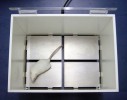Authors
T. Freret, V. Bouet, C. Leconte, S. Roussel, L. Chazalviel et al.
Lab
GMPc, Université de Caen Basse-Normandie, Caen, France.
Journal
Behavioral Neuroscience
Abstract
Distal occlusion of the middle cerebral artery (dMCAo), which closely mimics human stroke, is one of the most used animal models. However, although assessment of histological and functional outcome is increasingly recommended for preclinical studies, the latter is often excluded because of the high difficulties to estimate, especially in mice, behavioral impairments. The aim of our study was to deeply screen functional consequences of distal permanent MCAo in mice to target relevant behaviors for future studies. A set of sensorimotor and cognitive tests were performed during 3 weeks postsurgery in 2 groups of mice. Afterward, brain infarctions were estimated by histological staining or magnetic resonance imaging. Overall, while no long-term functional impairments could be detected, the adhesive removal was the only test showing a deficit. Interestingly, this sensorimotor impairment was correlated to cortical damage 3 weeks after surgery. In conclusion, despite the fact that dMCAo-induced deficits could not be evidenced by most of our behavioral tests, the authors showed that the adhesive removal test was the only one, sensitive enough, to highlight a long-term deficit. This result suggests therefore that this mouse model of ischemia is relevant to efficiently assess therapeutic strategies with histological but also behavioral analysis, provided that relevant tests are used.
BIOSEB Instruments Used:
Aron Test or Four Plates Test (LE830),Rotarod (BX-ROD)

 Pain - Thermal Allodynia / Hyperalgesia
Pain - Thermal Allodynia / Hyperalgesia Pain - Spontaneous Pain - Postural Deficit
Pain - Spontaneous Pain - Postural Deficit Pain - Mechanical Allodynia / Hyperalgesia
Pain - Mechanical Allodynia / Hyperalgesia Learning/Memory - Attention - Addiction
Learning/Memory - Attention - Addiction Physiology & Respiratory Research
Physiology & Respiratory Research
 Pain
Pain Metabolism
Metabolism Motor control
Motor control Neurodegeneration
Neurodegeneration Cross-disciplinary subjects
Cross-disciplinary subjects Muscular system
Muscular system General activity
General activity Mood Disorders
Mood Disorders Other disorders
Other disorders Joints
Joints Central Nervous System (CNS)
Central Nervous System (CNS) Sensory system
Sensory system

